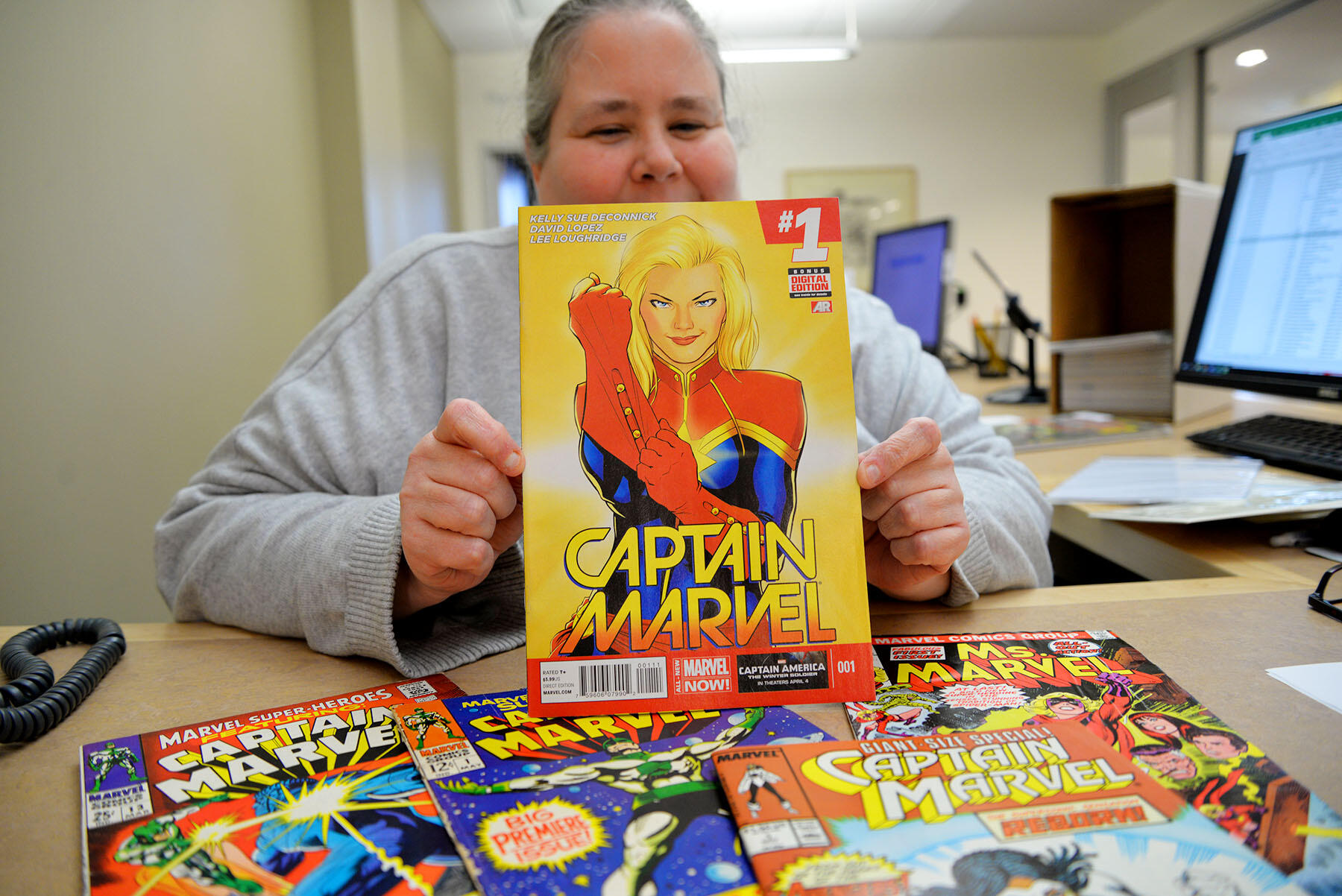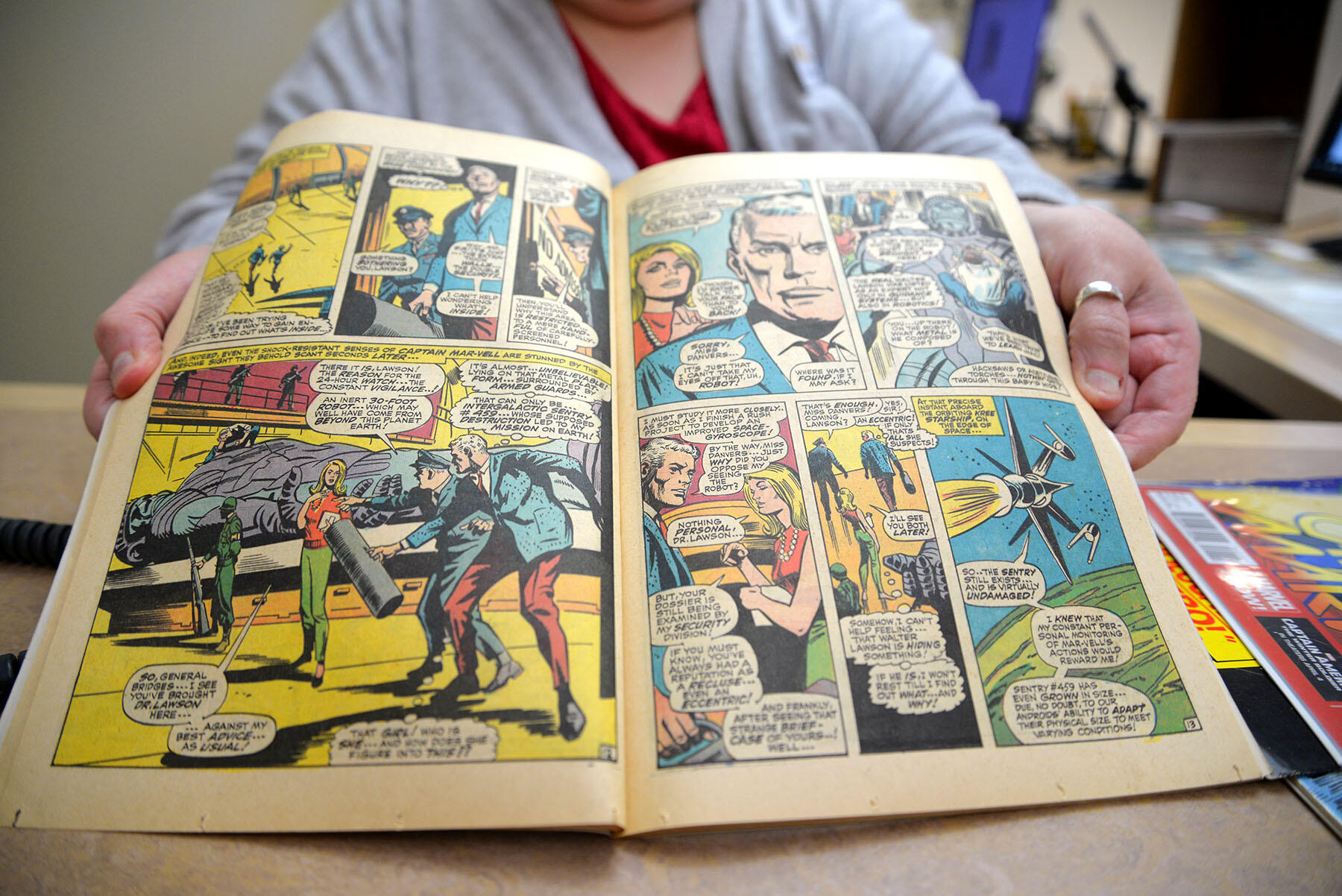
March 6, 2019
With ‘Captain Marvel,’ Marvel finally puts a feminist superhero in the cinematic spotlight, VCU expert says
Cindy Jackson, library specialist for comic arts, discusses this weekend’s release of the Marvel Cinematic Universe’s first female-led superhero movie.
Share this story
With “Captain Marvel,” the first solo female-superhero movie in the Marvel Cinematic Universe set to debut this weekend, Cindy Jackson, library specialist for comic arts in Special Collections and Archives at James Branch Cabell Library, pulled out an array of key “Captain Marvel” comics from VCU Libraries’ Comic Arts Collection.
The collection, which has more than 125,000 comic books among roughly 175,000 items, includes such issues as “Marvel Super-Heroes” No. 13, the first appearance of Carol Danvers, who will be played by Brie Larson in the film.
Jackson, an expert on the history of comics, discussed the history of Captain Marvel — the name of numerous characters dating back to the 1940s — and how the new film marks a step forward for Marvel and its goal of appealing to a diverse audience.
How significant is the fact that “Captain Marvel” will be the first Marvel film starring a female superhero?
This movie is the first time MCU has decided to step up and bring women to the forefront because that has been a criticism of the movies over the past decade.
Fans — especially female fans — have been clamoring for a Black Widow movie, of which one is now in the pipeline.
So the “Captain Marvel” movie is partly about appeasing fans. And Marvel was very smart in positioning it as the transition movie between “Avengers: Infinity War” and “Avengers: Endgame.” Captain Marvel plays an integral part in the upcoming “Endgame,” which will drive reluctant fanboys to go see the movie. They’re going to want to see how it ties in.
I think also that DC Comics really forced Marvel’s hand when they came out with the “Wonder Woman” movie and it was an unexpected hit. They knew it was going to do well, but it did better numbers than anyone anticipated. It appealed to a predominately female audience in a way superhero movies hadn’t before. Women went to see it, taking their daughters with them, and then went to see it again, and again.
That is a part of the fan base — the female fan — that Marvel discounts quite often. This movie is a way for them to attempt to rectify that oversight.
In the comics, Captain Marvel has been several different characters over the years, though this movie is focusing on Carol Danvers, who becomes Ms. Marvel in the ‘70s and Captain Marvel in 2012. What’s the historical context of the character in the comics?
It was more or less Marvel keeping trademark on the title. “Captain Marvel” has a long and convoluted history dating back to the ‘40s. The original “Captain Marvel” was published by Fawcett Comics. DC Comics sues Fawcett for copyright infringement in 1941, stating that Captain Marvel was too similar to Superman. The litigation drags on for over a decade and results in Fawcett ceasing publication of its superhero comics and settling the lawsuit in 1953. In the ‘60s, Marvel gets possession of the title through trademark when they publish their series. DC licensed the rights to the character in 1972 and outright purchased them in 1994 — and renamed the character Shazam, which is actually coming out as a movie in April.

Captain Marvel is seen by many as a feminist superhero. Do you think that will be reflected in the movie?
Oh yeah. You’re definitely going to see that. Marvel in the last five years or so has really made an effort, at least in the comics, to appeal to women because women have started coming back to superhero comics in droves after being shoved out of the genre all through the ‘90s.
Marvel came out a few years ago where, for example, Thor was female. And they’ve also tried to branch out with diversity. The current Ms. Marvel is a Muslim teenager and you have a Spider-Man who is a black Hispanic teenager, Miles Morales.
So they’re really trying to appeal across the fan base in a way that Marvel Comics had not really done prior, which is really interesting because in the ‘60s, Black Panther was created because Stan Lee and Jack Kirby saw an untapped market, which was the African-American community.
The Comic Arts Collection not only has all these great “Captain Marvel” comics, but thousands more comics published throughout the history of the medium. What do you think is the value of having such a collection in VCU Libraries?
Comics play a very important role in the cultural history of the U.S. in the 20th century, and the interest in comic scholarship has never been higher. VCU Libraries holds one of the largest comic arts research collections in the nation. We have a good number of important milestones in comics history in the collection, including things like “Captain Marvel” No. 1, both the Fawcett Comics and Marvel Comics editions, all of which are available to researchers.
Subscribe to VCU News
Subscribe to VCU News at newsletter.vcu.edu and receive a selection of stories, videos, photos, news clips and event listings in your inbox.













